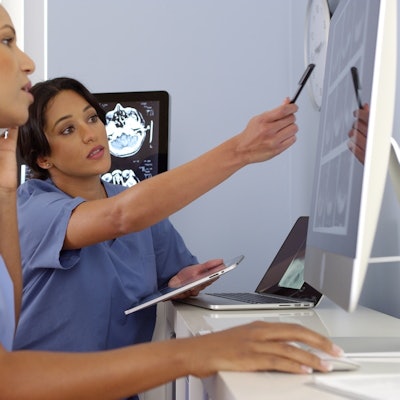
Radiology "handoffs" -- that is, transitioning patients to other departments or physician teams -- are crucial to effective patient care. But there's room for improvement, according to a study published May 11 in the Journal of the American College of Radiology.
Patient care transitions can pose particular challenges, especially around communication, wrote a group led by Dr. Judah Burns of Montefiore Medical Center in New York City.
"In radiology practice, frequent transitions of care responsibility among clinicians, radiologists, and patients occur between moments of care such as determining protocol, imaging, interpreting, and consulting," the group wrote. "As a leading cause of medical error, handoffs are a major communication challenge that is exceedingly common in both diagnostic and interventional radiology practice."
Much research has been conducted on patient care transitions for medicine, surgery, and nursing, but not as much for radiology, the team noted. Communication errors around imaging choices, protocols, follow-up study recommendations, and unclear written reports can not only endanger patients but also make radiologists vulnerable to litigation.
"Communication failures in these moments are among the top five causes of litigation against radiologists with higher rates of indemnity payments awarded because of delayed or missed diagnoses from these communication failures result in significant patient morbidity and mortality," the researchers wrote.
Burns and colleagues outlined three actions radiology departments can take to ensure safe care transitions:
- Focus on individual behaviors. Train staff on potential sources of error (i.e., order requests, report transcriptions, ineffective listening). Use tools like notetaking, repeating information back, checklists, screen-sharing, and virtual consults.
- Focus on team behaviors. Designate particular handoff times rather than conducting them "on the fly." "Wet reads and curbside consults are especially vulnerable to communication and accountability errors," the group noted. Reduce noise in team environments and limit interruptions. Make use of safety checklists for procedures.
- Develop organizational strength. Automate parts of the handoff protocol, such as reminders, exam orders, and reporting using the electronic health record. Establish a safety culture: "An organizational culture that prioritizes patient safety more closely aligns with provider goals, builds a stronger shared mental model of the role of handoffs in care transitions, and transforms handoffs from isolated communication events into true transfers of professional responsibility," the group wrote.
Improving patient care transitions is crucial on so many levels, and requires cooperation between individuals, teams, and organizations, according to the authors.
"Understanding handoffs in radiology allows us to enhance patient safety, transition radiology practices toward high-reliability organizations, and advance our application of health systems science by adding value to radiologic care," they concluded.




















